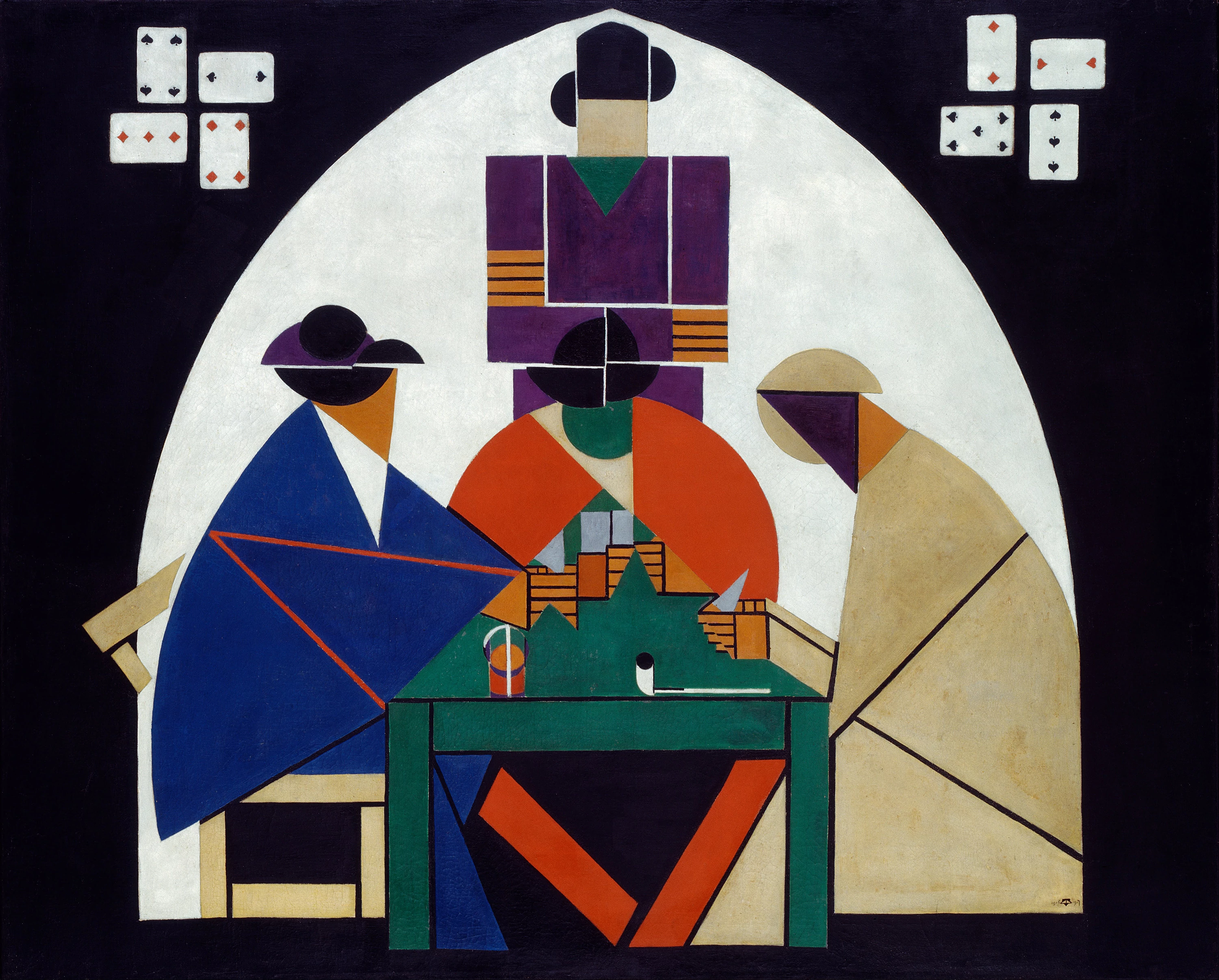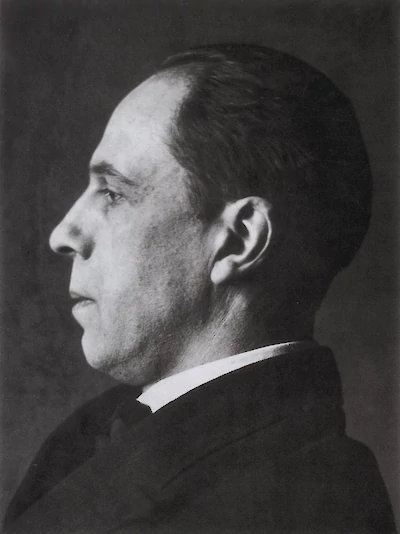

Theo van Doesburg
Ending a friendship over diagonal lines
1883 – 1931Elementarism was born, partly as a reaction against an all too dogmatic and often short-sighted application of Neoplasticism, partly as a consequence of Neoplasticism and, finally and chiefly, as a strict correction of Neoplasticist ideas.
Elementarism rejects the demand for an absolutely static state which would lead to rigidity and cripple creative potential.
Rather than denying the existence of time and space, Elementarism recognizes these factors as the most elementary of a new plasticism. Just as Elementarism tries to bring the two factors, statics and dynamics (rest and movement), into a balanced relationship, so equally does it strive to [214] combine these two elementary factors, time and space, into a new dimension. While the expressive possibilities of Neoplasticism are limited to two dimensions (the plane), Elementarism realizes the possibility of plasticism in four dimensions, in the field of time-space.
Elementarism opposes to the orthogonal method of plasticism, that is homogeneous with natural construction, a heterogeneous contrasting, labile method of expression by means of sloping planes relative to the static, perpendicular axis of gravity.
If Neoplasticism, through the banishment of the central method of composition, had already opened up new paths, Elementarism renews our optical impressions completely, it does not permit the work of art a left and a right half, and it destroys radically the Classical, optical frontality of the painting.
If all our physical movements are already based upon Horizontal and Vertical, it is only an emphasis of our physical nature, of the natural structure and functions of organisms if the work of art strengthens — although in an ‘artistic manner’ — this natural duality in our consciousness.
If Neoplasticism has already (and rightly) rejected symmetry, associated with our natural organic structure, it also lay in its line of development to reject orthogonalism, associated with our natural organic structure, as the only possible means of expression. This is what Elementarism does, when, through the suppression of a rigid static state, it arouses in us a new spiritual movement, accompanied by a new optics, which recognizes neither left nor right, neither symmetry, nor statics, nor the exclusively Horizontal-Vertical but is always in revolt, in opposition, to nature.
The construction method of Elementarism is based upon the abolition of positive and negative by the diagonal and, in respect of color, by the dissonant. Balanced relationship is not the final result. Elementarism rejects the modulation of colors against each other and of each color against the whole (the Classical concept of composition!) Elementarism acknowledges color as matter and as independent energy.
Elementarism rejects all artificial color value and opposes to it counter-value, i.e., variant against invariant, dissonant against contrast, and, finally, combinations of line and materials.
Elementarism opposes to the balanced relationship composition of Neoplasticism: non-balanced counter-composition as a phenomenon of a time-space tension of color, line or plane, always in opposition to the natural and architectural structure.
Elementarism completely excludes architecture as art.
From years of experiment and research it has been found that art and architecture are completely different and incompatible factors.
Elementarism is consciously striving for the end of arts and crafts and is hostile to any decorative application of the new principles. Elementarist principles, realized in architecture, produce an elementary architecture that is free of aesthetic intention.
Elementarism is directed not only to art, architecture and objects of utility, but also to living man and society. It wishes to renew the life concept, individually and collectively. It wishes to strengthen and arouse the spirit of opposition and revolt in the new generation, and counts upon making possible, collectively, with a great band of young people, a real, inner renewal of our mentality. This agitation, which is psychological rather than political, demands a heroic spontaneity. As a psychological, agitational movement, Elementarism is called Profundism.
The art renewals of the last twenty years have not been able to prevent individuals and society from being exclusively concerned with material interests. The material, natural well-being of individual or society has functioned and still functions as a measure of value. Completely different means from art are needed to raise man from his ignominious state (into which he was brought by religion) to a new, optimistic life concept. Elementarism provides the means and sympathizes with all movements (including those which propose other artistic principles) that make sacrifices for the renewal, liberation and enlargement of our life concept.
The increasing need for experience of reality is not to be confused with an increase of the materialistic concept of life.
The experience of reality is not to be regarded as the result of the old and almost conquered duality of spirit and matter.
In essence, spirit and matter are concepts of qualities that are to be equated with those of positive and negative, or of fast and slow, active and passive. In the experience of reality, used in my sense of the term, these two qualities have been neutralized and assumed to be a unity. Whether this experience of reality is ‘abstract’ is, from the Elementarist point of view, [216] a technical question and really to be regarded as secondary. It plays, at least in Elementarism, a secondary role. For the Elementarist, who sees the origin of polyrelativity in universal movement (not to be confused with displacement), spirit and matter, reality and super-reality, abstract and concrete are nothing more than formulae, under which category we have included the development of consciousness of the thought process up to the present time.
This thought process or this development of consciousness is the only reliable revelation of this polydimensional movement. Objective and subjective belong equally to this class of concept, of which Elementarism has washed its hands.
Elementarism begins where philosophy and religion have said their last word. These two have become fossilized in forms and formulae and have ceased to exist as spontaneous, living revelations of consciousness. Each consciousness presupposes an intellectual influence instead of an emotional one. The Elementarist denies emphatically any objective influence, he is aware that everything became, becomes and will become reality through the subject, who recognizes it. Emotion (art), work and intellect were the three organs of consciousness. The artist’s life consciousness led through emotion, that of the proletariat through work and that of the intellectual world through the analyzing intellect.
The great struggle which began with Elementarism is concerned with the following: to destroy completely the illusionist view of the world in all its forms (religion, stupor of nature and art, etc.,) and yet, at the same time, construct an elementary world of exact and splendid reality. It has the task of destroying, piece by piece, ornamental sculpture that conceals our world image, relics of religion and all other formal traditions.
The Elementarist is a spiritual rebel, an agitator, who wantonly disturbs at the expense of his own peace, the peace of the regularity and repetitiveness of bourgeois life. He does not break with form on a piece of canvas eighteen inches square, but does break with it irrevocably on the enormous plane of human tragedy.
He knows that man is a tragic animal who is able only through tradition to live as a preserved relic and through constant repetition of each day in one and the same way. He knows that this condition, this grace, is based upon some illusion or other, which is called now religion, now duty or honor. If this illusory relationship is abolished, there is abolished at the same [217] time the life possibility of the bourgeosie and of what sets itself above that. The Elementarist knows that these different forms of existence are only temporary, relative and transitory and have greater interest as generative than as cultural phenomena. A new cultural phenomenon was, for example, the discovery that the concepts spirit, body, soul, did not express any real life factors, and that these indications of consciousness can no longer have any real elementary, value.
Elementarism preaches the total destruction of traditional absolution in any form (the nonsense about a rigid opposition as between man and woman, man and god, good and evil, etc.) The Elementarist sees life as a vast expanse in which these life factors are constantly alternating with one another. The positive differences are only imaginary, and yet have become completely neutralized and uniform as reality. The Elementarist opposes to this uniformity the absolute concept of a universal movement. It even includes his personal ego. Thus neither does it give plastic expression to a fixed point, while consciousness as a product or goal of life occupies an elementary position (fulfillment of consciousness).
Paris, December 1925-April 1927, From De Stijl, Vol. VII, No. 78, pp. 82-87
Translated from the Dutch by Hans L.C. Jaffé. In De Stijl, H.N. Abrams. New York:1971.